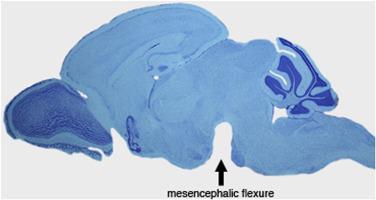当前位置:
X-MOL 学术
›
J. Chem. Neuroanat.
›
论文详情
Our official English website, www.x-mol.net, welcomes your
feedback! (Note: you will need to create a separate account there.)
The hypercholinergic brain of the Cape golden mole (Chrysochloris asiatica)
Journal of Chemical Neuroanatomy ( IF 2.7 ) Pub Date : 2020-12-01 , DOI: 10.1016/j.jchemneu.2020.101856 Adhil Bhagwandin 1 , Nhanisi Ndlovu 1 , Gary N Bronner 2 , Nigel C Bennett 3 , Paul R Manger 1
Journal of Chemical Neuroanatomy ( IF 2.7 ) Pub Date : 2020-12-01 , DOI: 10.1016/j.jchemneu.2020.101856 Adhil Bhagwandin 1 , Nhanisi Ndlovu 1 , Gary N Bronner 2 , Nigel C Bennett 3 , Paul R Manger 1
Affiliation

|
Studies detailing the anatomy of the brain of the golden moles are few. A recent study indicated that in the Hottentot golden mole (a member of the Amblysominae clade), there was a broad, atypical, distribution of cholinergic interneurons in the olfactory bulb, cerebral cortex, hippocampus and amygdala. To determine whether this broad distribution of cholinergic neurons is shared by other species of golden mole, we here examine the brain of the Cape golden mole (a member of the Chrysochlorinae clade, representing the second major clade within the family Chrysochloridae). Our analyses indicates the presence of a similar widespread distribution of cholinergic interneurons in the Cape golden mole. Thus, we conclude that these features are derived morphological traits in the brains of golden moles. In addition, we describe the nuclei generally considered to be part of the typical cholinergic system in mammals. Whereas the vast majority of these generally reported cholinergic nuclei were the same as recorded in other Eutherian mammals, it was noted that the cholinergic nuclei involved in oculomotion were substantially reduced in size, or absent in the case of the abducens nucleus. In addition, there was an absence of the cholinergic medial septal nucleus, but the presence of a cholinergic lateral septal nucleus. The laterodorsal and pedunculopontine tegmental nuclei evince regions where the cholinergic neurons are densely packed. These are atypical features of the mammalian cholinergic system, which when combined with the widespread atypical distribution of cholinergic interneurons, reveals a family-specific complement of cholinergic nuclei in the Chrysochloridae.
中文翻译:

开普金鼹鼠 (Chrysochronis asiatica) 的高胆碱能大脑
详细描述金鼹鼠大脑解剖结构的研究很少。最近的一项研究表明,霍屯督金鼹鼠(Amblysominae 分支的成员)的嗅球、大脑皮层、海马体和杏仁核中存在广泛的、非典型的胆碱能中间神经元分布。为了确定其他种类的金鼹鼠是否也具有这种广泛的胆碱能神经元分布,我们在这里检查了开普金鼹鼠(金鼹鼠科的成员,代表金鼹科中的第二个主要分支)的大脑。我们的分析表明,海角金鼹鼠中存在类似的广泛分布的胆碱能中间神经元。因此,我们得出结论,这些特征源自金鼹鼠大脑的形态特征。此外,我们描述了通常被认为是哺乳动物典型胆碱能系统一部分的细胞核。虽然这些普遍报道的胆碱能核中的绝大多数与其他真兽类哺乳动物中记录的相同,但值得注意的是,参与动眼运动的胆碱能核的大小大大减小,或者在外展核的情况下不存在。此外,不存在胆碱能内侧间隔核,但存在胆碱能外侧间隔核。背侧和桥脚被盖核显示出胆碱能神经元密集的区域。这些是哺乳动物胆碱能系统的非典型特征,当与胆碱能中间神经元的广泛非典型分布相结合时,揭示了金黄科胆碱能核的家族特异性补充。
更新日期:2020-12-01
中文翻译:

开普金鼹鼠 (Chrysochronis asiatica) 的高胆碱能大脑
详细描述金鼹鼠大脑解剖结构的研究很少。最近的一项研究表明,霍屯督金鼹鼠(Amblysominae 分支的成员)的嗅球、大脑皮层、海马体和杏仁核中存在广泛的、非典型的胆碱能中间神经元分布。为了确定其他种类的金鼹鼠是否也具有这种广泛的胆碱能神经元分布,我们在这里检查了开普金鼹鼠(金鼹鼠科的成员,代表金鼹科中的第二个主要分支)的大脑。我们的分析表明,海角金鼹鼠中存在类似的广泛分布的胆碱能中间神经元。因此,我们得出结论,这些特征源自金鼹鼠大脑的形态特征。此外,我们描述了通常被认为是哺乳动物典型胆碱能系统一部分的细胞核。虽然这些普遍报道的胆碱能核中的绝大多数与其他真兽类哺乳动物中记录的相同,但值得注意的是,参与动眼运动的胆碱能核的大小大大减小,或者在外展核的情况下不存在。此外,不存在胆碱能内侧间隔核,但存在胆碱能外侧间隔核。背侧和桥脚被盖核显示出胆碱能神经元密集的区域。这些是哺乳动物胆碱能系统的非典型特征,当与胆碱能中间神经元的广泛非典型分布相结合时,揭示了金黄科胆碱能核的家族特异性补充。











































 京公网安备 11010802027423号
京公网安备 11010802027423号